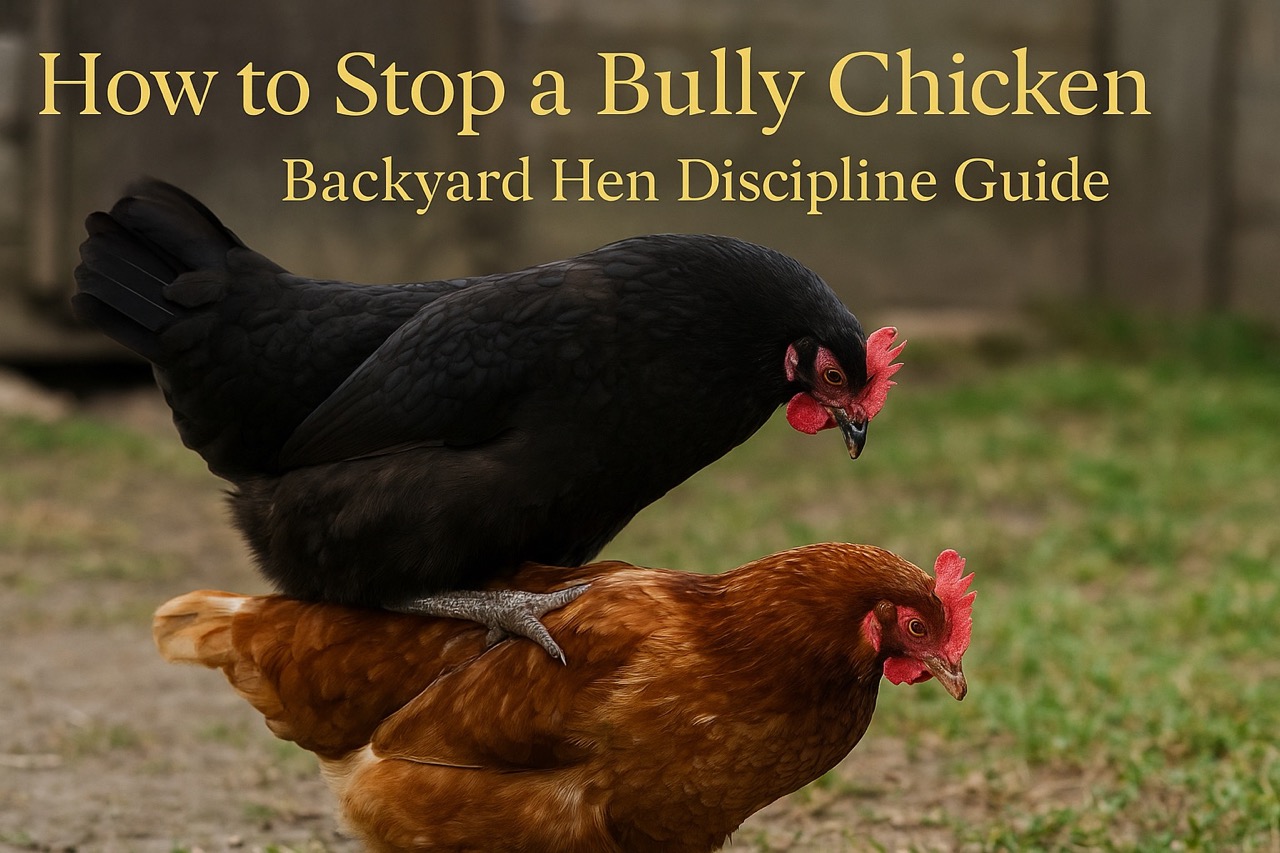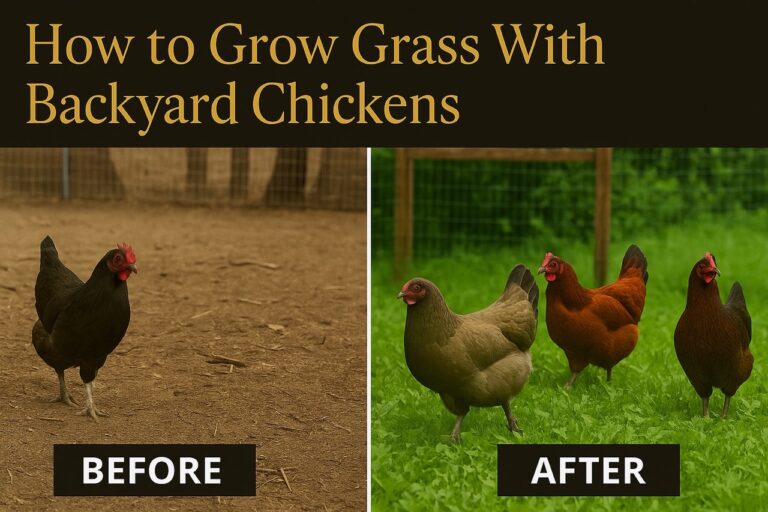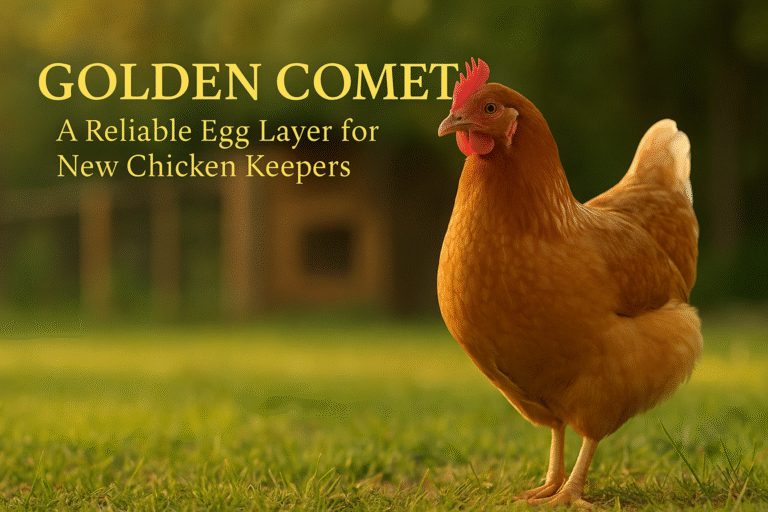It started like any other day in the coop. The sun rose, the feeder clanged, and chickens fluffed their feathers. But then, like a feathery wrecking ball, my Black Sex Link hen launched herself onto one of my sweet Marans and started pecking the daylights out of her head. Again.
I watched as she jumped on her back, stood like a queen of violence, and pecked the comb like it owed her money. The Marans didn’t fight back. None of them did. And that’s when I knew: I had a bully chicken on my hands.
🐔 The Pecking Order Gone Wrong
Chickens have a natural hierarchy called the pecking order. A little squabbling is expected when new birds are introduced or when roles shift. But when one hen goes full dictator — mounting other hens, drawing blood, ripping feathers out — it’s not just pecking order. It’s bullying.
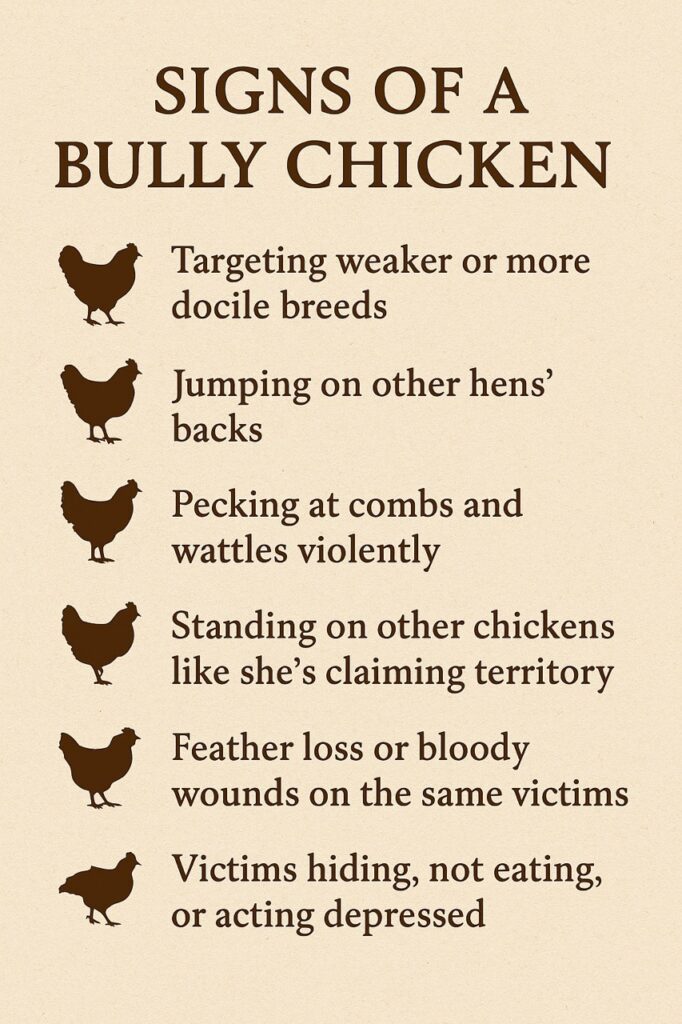
⚠️ Signs You Have a Bully Chicken
- Targeting weaker or more docile breeds
- Jumping on other hens’ backs
- Pecking at combs and wattles violently
- Standing on other chickens like she’s claiming territory
- Feather loss or bloody wounds on the same victims
- Victims hiding, not eating, or acting depressed
💣 Breeds That Tend to Be Bullies
While any hen can turn mean, Black Sex Links, ISA Browns, and other high-output hybrid layers are often more aggressive. They’re bred to be hardy egg machines, not gentle flockmates. On the flip side, breeds like Marans, Rhode Island Reds, and Barred Rocks are more mid-pack or passive, and often the ones targeted.
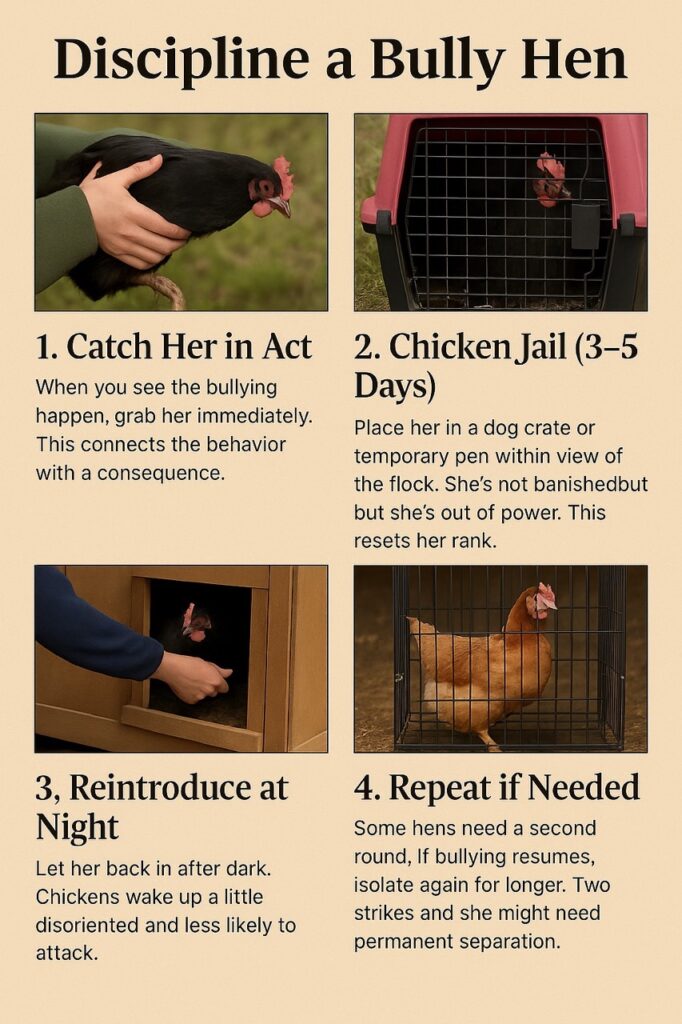
⚒️ The Fix: How to Discipline a Bully Hen
1. Catch Her in the Act
When you see the bullying happen, grab her immediately. This connects the behavior with a consequence.
2. Chicken Jail (3–5 Days)
Place her in a dog crate or temporary pen within view of the flock. She’s not banished but she’s out of power. This resets her rank.
3. Reintroduce at Night
Let her back in after dark. Chickens wake up a little disoriented and less likely to attack.
4. Repeat if Needed
Some hens need a second round. If bullying resumes, isolate again for longer. Two strikes and she might need permanent separation.
🧰 Help for the Victims
- Apply Blue-Kote or Pick-No-More to wounds (the color hides red and discourages more pecking)
- Use chicken saddles or vet wrap to protect featherless backs and legs
- Add hiding spaces, perches, or hanging distractions to break sightlines
🧠 Why Do Hens Turn Violent?
- No rooster? A dominant hen may take the alpha role
- Overcrowding or boredom leads to aggression
- Nutritional imbalances can increase pecking (too much corn, not enough protein)
- Some birds are just wired that way
🤠 My Real-Life Chicken Jail Story
My Black Sex Link was the queen of chaos. Every morning she launched a surprise attack on the Marans. I thought about rehoming her… or something darker. But instead, I grabbed her mid-peck, stuck her in a cage with nothing but food, water, and shame. Three days of solitary.
When I let her back in at night, she strutted like she still owned the place — but something had changed. The victims stood taller. She tried one peck and got ignored. No drama.
A week later, she was still bossy, but no longer violent. And peace returned to the flock.
📰 Final Thoughts: You’re Not Alone
Every chicken keeper eventually meets a mean hen. It doesn’t mean your flock is doomed. With a little discipline, some creative jail time, and attention to space and nutrition, you can stop a bully chicken without resorting to violence or rehoming.
Have your own flock feud story? Drop it in the comments or send a picture of your “chicken jail” setup. We’re in this together.
🔗 Related Reading
- Broody Hen Behavior: Why She’s Not Leaving the Nest
- Optimal Chicken Space Requirements
- Backyard Chickens and Mental Health
- Best Chicken Breeds for Beginners
- Low-Cost Chicken Feed Ideas
- What Not to Feed Chickens (Common Mistakes & Dangers)
- Backyard Chickens: Building Community and Sustainability
- Chicken Dust Bath Guide
- Rhode Island Red Chicken Breed Guide
- Marans Chicken Breed Guide
🌐 Related Reading (External Sources)
- Understanding the Pecking Order in Chickens
Backyard Chicken Coops – A comprehensive guide to the social hierarchy in chicken flocks. - Chicken Bullying: How to Stop Them Pecking Each Other
The Happy Chicken Coop – Practical advice on identifying and curbing bullying behavior in chickens. - Severe Feather-Pecking in Chickens: Signs, Treatment & Prevention
PoultryDVM – Veterinary insights into severe feather pecking and its management. - How Do I Introduce New Chickens Into My Old Flock?
My Pet Chicken – Tips for smoothly integrating new birds into an existing flock. - Raising Chickens 101: How to Get Started
The Old Farmer’s Almanac – A beginner’s guide to starting your own backyard flock. - Handling a Bully in Your Chicken Flock
Fresh Eggs Daily – Strategies for managing and rehabilitating aggressive hens. - Chicken Saddles: What They Are & When to Use One
Tilly’s Nest – Information on using chicken saddles to protect hens from feather loss.
FAQ
🐔 Understanding Chicken Bullying
Q: What is a bully chicken and how can I tell if I have one?
A: A bully chicken is a hen that repeatedly attacks, chases, or pecks other flock members beyond normal pecking order behavior. Signs include feather loss, hiding, bloody combs, and repeated targeting of the same birds.
Q: Is it normal for hens to jump on other hens’ backs?
A: Occasionally, this is a dominance behavior. But if a hen frequently mounts and pecks others violently, she may be asserting control like a rooster or acting aggressively due to stress or lack of structure.
Q: Why is my hen attacking other chickens all of a sudden?
A: Sudden aggression may be triggered by stress, overcrowding, changes in flock structure, boredom, or health imbalances. Hormonal shifts can also make hybrid hens more dominant.
⚖️ Managing the Pecking Order
Q: How long does it take chickens to establish a pecking order?
A: Usually 1–2 weeks, but disruptions (new birds, removed birds, coop changes) can restart the hierarchy process and increase pecking temporarily.
Q: Can chickens kill each other in a flock?
A: Yes. While rare, relentless bullying can lead to death through blood loss, stress, or injury if not stopped. Chickens are drawn to red wounds and can peck a victim to death.
Q: Should I separate a chicken that’s being bullied?
A: No, if possible avoid removing the victim — it reinforces their low rank. Instead, remove the bully for a few days to break the cycle and allow victims to regain confidence.
🚫 Stopping Bully Behavior
Q: How do I stop a chicken from bullying the others?
A: Use the “chicken jail” method: remove the bully for 3–5 days in view of the flock. This resets her social rank. Also provide distractions, more space, and apply anti-peck sprays to injured birds.
Q: Does hitting or punishing a chicken work?
A: No. Chickens don’t respond to physical discipline like mammals. Instead, use isolation and environmental changes to redirect behavior.
Q: What is a chicken timeout cage or chicken jail?
A: A small pen or crate where the bully hen is isolated from the flock (but within sight) for 3–5 days. It temporarily removes her power and disrupts her dominance.
🧠 Behavior, Health, and Triggers
Q: Can lack of protein cause chickens to peck each other?
A: Yes. A protein-deficient diet can lead to feather-picking and aggression. Ensure layer feed contains 16–18% protein and avoid excess scratch grain or corn.
Q: Do chickens get bored and start pecking?
A: Definitely. Boredom can lead to destructive behavior. Add perches, hanging treats, cabbage heads, or dust bath areas to enrich their environment.
Q: Can one chicken become the “alpha” in a flock without a rooster?
A: Yes. In the absence of a rooster, one hen often steps up as the dominant leader. Some hybrid hens may become more aggressive in this role.
🛡️ Protecting Injured or Targeted Chickens
Q: What can I put on a chicken wound to stop others from pecking it?
A: Use products like Blue-Kote or Pick-No-More lotion. These cover the red wound and have a bitter taste to discourage further pecking.
Q: What is a chicken saddle and when should I use one?
A: A chicken saddle is a cloth cover worn by a hen to protect her back from feather pecking or rooster mating damage. They’re great for bullied hens healing from back injuries.
Q: How do I keep a picked-on hen safe without removing her from the flock?
A: Give her hiding spots, apply anti-peck spray, and reduce stressors. Only isolate her if she’s severely injured and needs medical recovery.
🧰 Prevention and Long-Term Strategies
Q: What breeds are less likely to bully others?
A: Gentler breeds include Orpingtons, Australorps, Silkies, and Marans. Avoid mixing them with more assertive hybrids like Black Sex Links or ISA Browns.
Q: How much space do chickens need to avoid aggression?
A: At minimum, provide 4 square feet per bird in the coop and 10–12 square feet per bird in the run. Overcrowding almost always increases pecking and bullying.
Q: Can I add new chickens to my flock without causing fights?
A: Yes, but do so gradually using a quarantine and side-by-side introduction method over 7–14 days. Sudden introduction triggers pecking order aggression.

